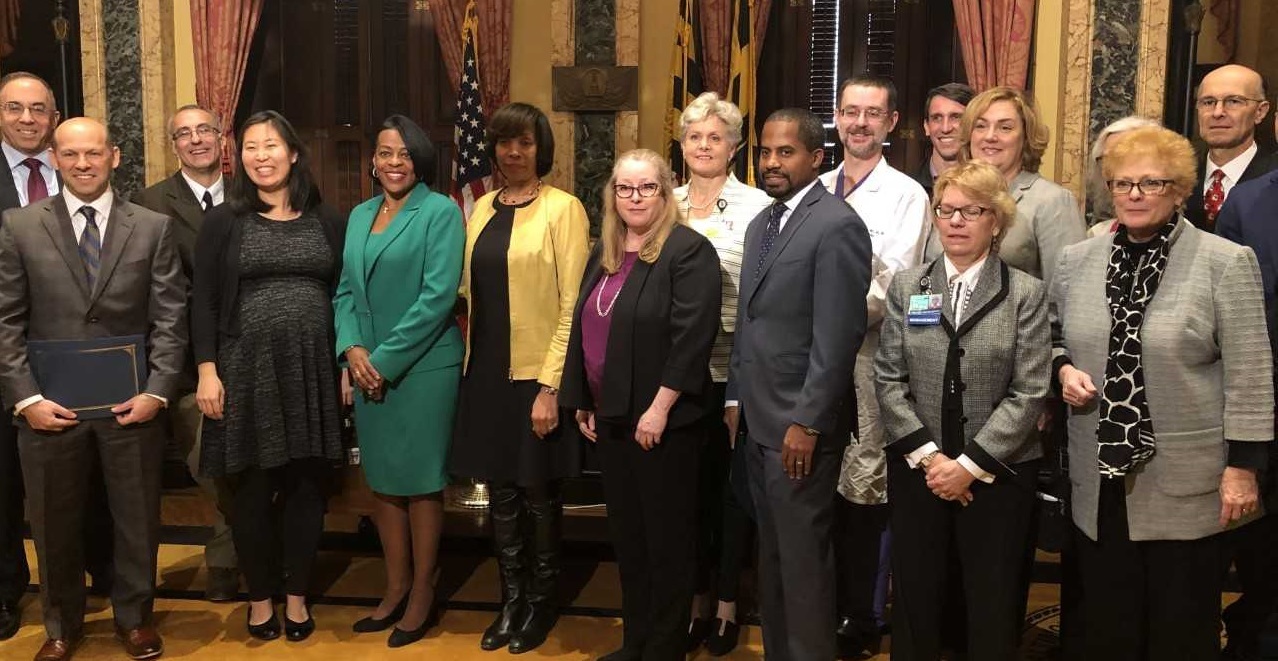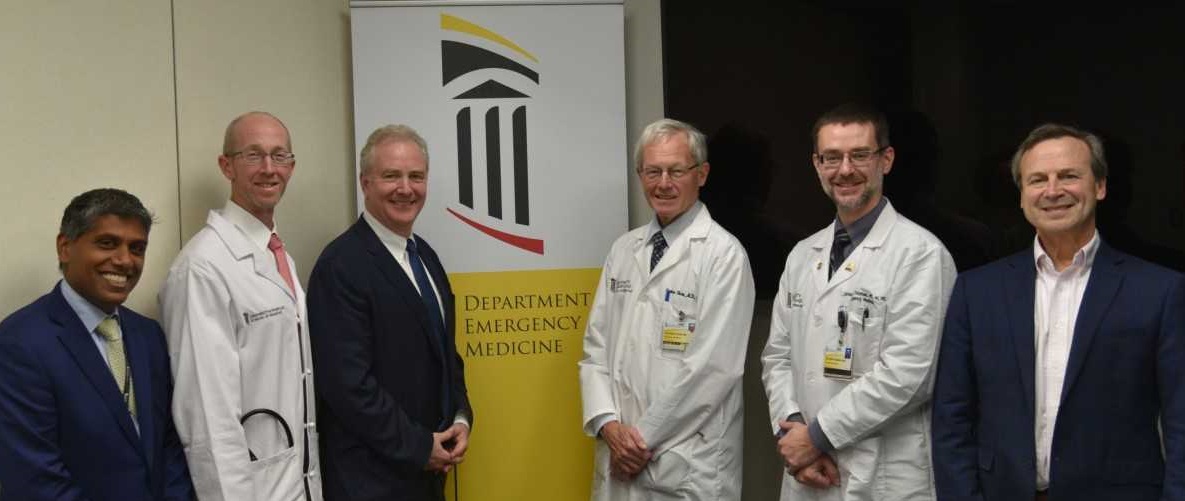At a press conference held at Baltimore’s City Hall on December 19, Mayor Catherine Pugh announced that the University of Maryland Medical Center’s midtown and downtown campuses have been awarded “Level 1” status, the highest certification in the city’s efforts toward addressing the opioid epidemic. The city’s Levels of Care initiative assesses hospitals’ ability to provide treatment to patients who screen positive for a substance use disorder, distribute naloxone to patients, and ensure physicians are prescribing opioids judiciously. Of the 11 hospitals assessed, UMMC and Midtown were the only two in the top tier of readiness and resources to offer comprehensive and timely treatment to ED patients struggling with opioid addiction."
Zachary D.W. Dezman, MD, MS, MS, chair of Midtown’s Opioid Task Force, noted that “a staggering 70% of patients who come to our EDs for care are struggling with addiction, behavioral health problems, or both. About one in every 50 patients treated at Midtown's ED is suffering from an overdose of some kind. We offer patients resources to put them on a path toward healing, including dispensing naloxone to those at high risk for overdose and providing peer recovery support services. Those peers can link patients with substance abuse problems to inpatient treatment programs within hours.”
UMMC’s Opioid Task Force is co-chaired by Christopher Welsh, MD, and R. Gentry Wilkerson, MD. Attendees at the Wednesday morning press conference included Reginald Brown, MD, ED Director, Bon Secours; Michael Jablonover, MD, MBA, CMO and Senior Vice President of UMMC; Mary Beth Haller, interim Baltimore Health Commissioner; and Alison Brown, MPH, President of UMMC’s Midtown Campus.

Jenny Guyther, MD, and Danya Khoujah, MBBS, were faculty members for the National Continued Competency Program Paramedic Refresher course, held at the University of Maryland, Baltimore County, during the week of October 30. Dr. Guyther’s lectures were titled “What a Pain! A Closer Look at Head and Neck Trauma” and “Challenging the Status Quo: Where the EMS Literature is Taking Us.” Dr. Khoujah presented three lectures: “Stroke: Beyond the Basics,” “Seizures,” and “Pearls and Pitfalls of Managing Psychiatric Emergency.” The course was sponsored by UMBC’s Department of Emergency Health Services.
Laura Diegelmann, MD, RDMS, was a site coordinator for an international study on the use of ultrasound in the assessment of nontrauma patients with hypotension without an obvious cause. The study involved patients from three medical centers in North America and three in South Africa. Point-of-care ultrasound conveyed no demonstrable outcome benefit to patients with undifferentiated shock. The results of this study were published as the article titled “Does Point-of-Care Ultrasonography Improve Clinical Outcomes in Emergency Department Patients with Undifferentiated Hypotension? An International Randomized Controlled Trial from the Shoc-ED Investigators” in the October issue of Annals of Emergency Medicine.
Wendy Chang, MD, collaborated with investigators from the Departments of Neurology, Anesthesiology, and Surgery in an analysis of clinical information from patients enrolled in the Oximetry and Noninvasive Predictors of Intervention Need after Trauma (ONPOINT) study. They concluded that continuous vital sign variability and waveform analysis of the electrocardiogram or photoplethysmogram within the first hour after resuscitation constitutes a noninvasive marker of neurologic decline after traumatic brain injury.
Their work was published as the following article:
Melinosky C, Yang S, Hu P, Li H, Miller CHT, Khan I, Mackenzie C, Chang WT, Parikh G, Stein D, Badjatia N. Continuous vital sign analysis to predict secondary neurological decline after traumatic brain injury. Frontiers in Neurology 2018 Sep 25;9:761.
US Senator Chris Van Hollen (D-MD) visited UMMC's emergency department on November 1 to discuss the effects of the opioid crisis on ED operations, the use fentanyl among ED patients, and the administration of buprenorphine to patients seeking treatment or in withdrawal. Joining in that conversation were (left to right) Mohan Suntha, MD, MBA, President and Chief Executive Officer, University of Maryland Medical Center, Michael E. Winters, MD, MBA, Senator Van Hollen, Stephen R. Thom, MD, PhD, Zachary D.W. Dezman, MD, MS, MS, and Eric Weintraub, MD, Department of Psychiatry.

Amal Mattu, MD, conducted a 21-hour course on emergency cardiology in Sarasota, Florida, from October 22 to 26. The CME course, titled "Emergency Cardiology: Beyond A-B-C and ACLS," was sponsored by American Medical Seminars. Content included electrocardiographic workshops covering cardiac ischemia and its mimics, advanced dysrhythmia recognition and management, and critical ECG findings in patients with syncope. In addition, Dr. Mattu presented lectures on cardiogenic pulmonary edema, cardiac arrest, acute coronary syndromes, low-risk chest pain, and legal pitfalls in emergency cardiology. The course was attended by over 100 health care providers in emergency medicine, internal medicine, family medicine, anesthesiology, cardiology, cardiothoracic surgery, and critical care from the United States, Canada, and the Caribbean.
Zachary Dezman, MD, MS, MS, and Jon Mark Hirshon, MD, PhD, MHS, co-authored the article titled "Repeat Lactate Level Predicts Mortality Better Than Rate of Clearance," pubilshed in the November issue of American Journal of Emergency Medicine. Their collaborators in this project were three investigators who have been studying the fine points of trauma epidemiology and resuscitation for decades: Peter Hu, MS, PhD, and Colin Mackenzie, MD,ChB, from the Department of Anesthesiology, and Gordon Smith, MB,ChB, MPH, from the Department of Epidemiology and Pubic Health, as well as Thomas Scalea, MD, The Honorable Francis X. Kelly Distinguished Professor in Trauma Surgery. The statistician for this work was Angela Comer, MS, formerly affliated with the National Study Center for Trauma and Emergency Medical Systems.
The use of buprenorphine in the ED at UMMC’s Midtown Campus is discussed in a recent article in the Washington Post:
In that article, Dr. Zachary Dezman explains that opioid-addicted patients seen “after hours” are offered an initial dose of the anti-addiction medication rather than simply being sent home and advised to go to a treatment center. Numerous studies have shown this “jumpstart” on treatment to be effective in helping people seek help and eventually kick their habit.
An unusual consequence of unconsciousness is described in a case report published earlier this month by Eric Friedman, MD, and Ken Butler, DO. “Not Just Another 'Found Down': Concomitant Upper Arm and Gluteal Compartment Syndrome” is available at the website of The Journal of Emergency Medicine (www.jem-journal.com/article/S0736-4679(18)30918-1/pdf).
Jon Mark Hirshon, MD, PhD, MPH, was elected Vice-President of the American College of Emergency Physicians at the organization’s Scientific Assembly in San Diego. His duties in this role include being the key liaison to the Emergency Medicine Residents’ Association and to Annals of Emergency Medicine. ACEP, a national medical specialty society with 40,000 members, is committed to advancing emergency care through continuing education, research and public education.
Blog Archives
2025
2024
2023
2022
2021
2020
2019
2018
2017
2016
2015
2014
2013
2012
